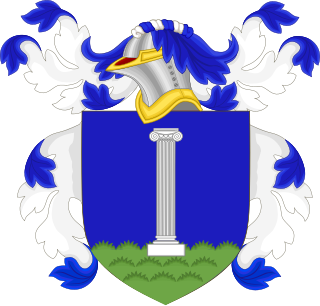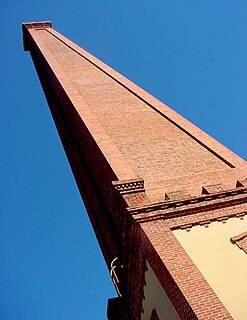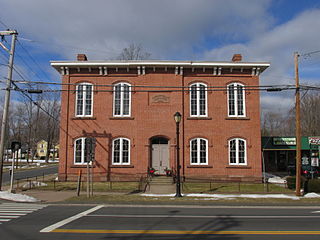The Hazard Powder Company is a former American manufacturer of gunpowder and explosives. It was located in Hazardville within the town of Enfield, Connecticut.




The Hazard Powder Company is a former American manufacturer of gunpowder and explosives. It was located in Hazardville within the town of Enfield, Connecticut.




The company was founded on the Scantic River in 1835 by Allen Loomis in an area then known as Powder Hollow, with the construction of a small gunpowder mill. A company called Loomis, Denslow and Company, named for Loomis and his business partner, was established the following year. [1] [2] The company manufactured powder from saltpeter, sulfur, and charcoal. [3]
Employees lived in a company town named Hazardville, which took its name from Colonel Augustus George Hazard, [4] who bought into the company in 1837 and eventually built it to become a major producer of gunpowder. The company changed its name to Loomis, Hazard & Company in 1837, and became the Hazard Powder Company in 1843 when Hazard bought Loomis' share of the business.
Production increased over the years in response to the needs of the U.S. military for gunpowder during the Mexican–American War, demand for blasting powder during the California Gold Rush of 1849, and the Crimean War, when the Hazard Powder Company supplied both Britain and Russia with gunpowder, shipping a total of 500 tons to Britain. During the American Civil War, the mill was one of the three chief sources of gunpowder for the Union forces, producing up to 12,500 lb (5,700 kg) a day.
At its peak, the Hazard Powder Company operated in 125 buildings occupying hundreds of acres of land. [1] [2] [3] It had 25 water wheels and three steam engines along a mile of Scantic River frontage. There were additional mills in East Hartford and Canton. [5] The business declined after the Civil War. [1] [2] [3] However, Hazardville still had a relatively large population of 1,500 in the 1890s. [6]
Hazard Powder was one of the three largest (with DuPont and Laflin & Rand) among the six companies of the United States Gunpowder Trade Association (popularly known as the powder trust). [7] DuPont gained majority stock control of the company in 1876 after Colonel Hazard died in 1868. [5] The plant became part of Hercules Powder Company when DuPont assets were divided in 1912 under provisions of the Sherman Antitrust Act, and it closed permanently after a major explosion on January 14, 1913, destroyed much of the plant. [1] [2] [3]

Gunpowder, also commonly known as black powder to distinguish it from modern smokeless powder, is the earliest known chemical explosive. It consists of a mixture of sulfur, carbon and potassium nitrate (saltpeter). The sulfur and carbon act as fuels while the saltpeter is an oxidizer. Gunpowder has been widely used as a propellant in firearms, artillery, rocketry, and pyrotechnics, including use as a blasting agent for explosives in quarrying, mining, and road building.

Enfield is a town in Hartford County, Connecticut, United States, first settled by John and Robert Pease of Salem, Massachusetts Bay Colony. The population was 42,141 at the 2020 census. It is bordered by Longmeadow, Massachusetts, and East Longmeadow, Massachusetts, to the north, Somers to the east, East Windsor and Ellington to the south, and the Connecticut River to the west.

Hazardville is a section of the town of Enfield, Connecticut, in Hartford County. It is a census-designated place (CDP) that had a total population of 4,599 as of the 2010 census.
E. I. du Pont de Nemours and Company, commonly referred to as DuPontalso, was an American company that was founded in July 1802 in Wilmington, Delaware, as a gunpowder mill by French-American chemist and industrialist Éleuthère Irénée du Pont de Nemours.

Éleuthère Irénée du Pont de Nemours was a French-American chemist and industrialist who founded the gunpowder manufacturer E. I. du Pont de Nemours and Company. His descendants, the du Pont family, have been one of America's richest and most prominent families since the 19th century, with generations of influential businessmen, politicians and philanthropists. In 1807, du Pont was elected a member of the American Philosophical Society in his adopted hometown of Philadelphia.

The Hagley Museum and Library is a nonprofit educational institution in unincorporated New Castle County, Delaware, near Wilmington. Covering more than 235 acres (95 ha) along the banks of the Brandywine Creek, the museum and grounds include the first du Pont family home and garden in the United States, the powder yards, and a 19th-century machine shop. On the hillside below the mansion lies a Renaissance-revival garden, with terraces and statuary, created in the 1920s by Louise Evalina du Pont Crowninshield (1877–1958).

The Du Pont family is a prominent American family descended from Pierre Samuel du Pont de Nemours (1739–1817). It has been one of the richest families in the United States since the mid-19th century, when it founded its fortune in the gunpowder business. In the late 19th and early 20th centuries, it expanded its wealth through the chemical industry and the automotive industry, with substantial interests in the DuPont company, General Motors, and various other corporations.

The Confederate Powderworks was a gunpowder factory during the American Civil War, the only permanent structures completed by the Confederate States of America. Colonel George Washington Rains chose the old United States Arsenal site between the Canal and Savannah River in Augusta, Georgia, as a secure inland location with good rail and water connections.
Hercules, Inc. was a chemical and munitions manufacturing company based in Wilmington, Delaware, United States, incorporated in 1912 as the Hercules Powder Company following the breakup of the DuPont explosives monopoly by the U.S. Circuit Court in 1911. Hercules Powder Company became Hercules, Inc. in 1966, operating under this name until 2008, when it was merged into Ashland Inc.

From 1802 to 1921, Eleutherian Mills was a gunpowder mill site used for the manufacture of explosives founded by Eleuthère Irénée du Pont, which grew into the DuPont company. The name also refers to the house on the hill above the mills, which was the first du Pont family home in America. In 1957 the site became an outdoor museum when the Hagley Museum and Library was founded. The site was declared a National Historic Landmark in 1966.

A powder mill was a mill where gunpowder is made from sulfur, saltpeter and charcoal.

The Hazardville Historic District is a historic district in the Hazardville section of Enfield, Connecticut, United States, that is listed on the National Register of Historic Places.
Augustus George Hazard, known as Colonel Augustus Hazard, was an American manufacturer of gunpowder and the namesake of Hazardville, Connecticut.

California Powder Works was the first American explosive powder manufacturing company west of the Rocky Mountains. When the outbreak of the Civil War cut off supplies of gunpowder to California's mining and road-building industries, a local manufacturer was needed. Originally located near Santa Cruz, California, the company was incorporated in 1861 and began manufacturing gunpowder in May 1864. For 50 years, it was a major employer in the county, employing between 150 and 275 men. The powder works was located on a flat adjacent to the San Lorenzo River, three miles upstream of Santa Cruz.
Oriental Powder Company was a gunpowder manufacturer with mills located on the Presumpscot River in Gorham and Windham, Maine. The company was one of the four largest suppliers to Union forces through the American Civil War.

Laflin & Rand Powder Company was a gunpowder and early smokeless powder manufacturer notable for producing the smokeless powder used by United States Army infantry rifles from 1896 to 1908, which included the period of development of the M1903 Springfield rifle and .30-06 Springfield cartridge.

Henry du Pont was an American military officer and businessman from Delaware, and a member of the Du Pont family.
American Powder Mills (1883–1929) was a Massachusetts gunpowder manufacturing complex on the Assabet River. It expanded to include forty buildings along both sides of the river in the towns of Acton, Concord, Maynard, and Sudbury. Press mills, kernelling mills, glazing mills, and storehouses were dispersed over four-hundred acres to minimize damage during explosions. A narrow gauge railway transferred raw materials and products between the buildings.
Miami Powder Company operated a gunpowder manufacturing complex on the Little Miami River at Goes Station, Ohio from 1855 to 1925. Willows growing along the banks of the Little Miami River provided the charcoal required for gunpowder. Production was approximately 75 percent rifle powder and 25 percent blasting powder.